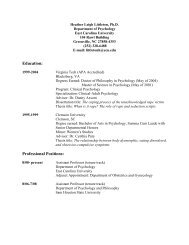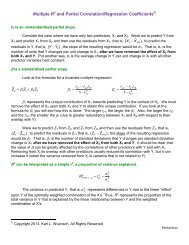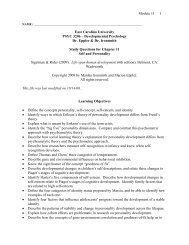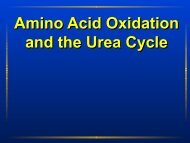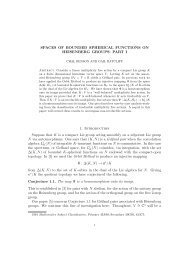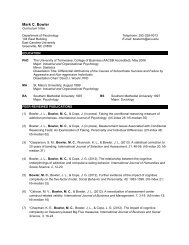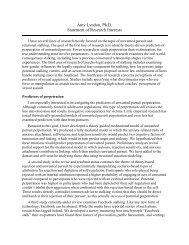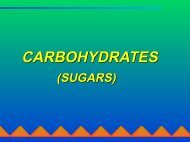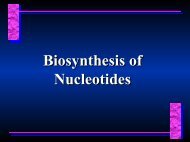308J. J. LUCZKOVICH ET AL.without loss of relational <strong>in</strong>formation. If twocolors blue <strong>and</strong> red are mutually connected <strong>in</strong>the image graph, then, <strong>in</strong> the orig<strong>in</strong>al graph,every blue node has a connection to every rednode, <strong>and</strong> every red node has an <strong>in</strong>com<strong>in</strong>g tiefromevery blue node.The image graph of a regular equivalence alsoprovides a reduced model of the network(s) as awhole. Unlike structural equivalence, however,with regular equivalence there is some loss ofrelational <strong>in</strong>formation, although the extent <strong>and</strong>type of loss are strictly controlled. Figure 2(b)gives the image graph associated with the regularequivalence <strong>in</strong> Fig. 1(e). Given the rules of aregular equivalence, we are guaranteed that if, <strong>in</strong>the image graph, there is a tie from a verticall<strong>in</strong>ednode to a cross-hatched node, then <strong>in</strong> theorig<strong>in</strong>al graph, every cross-hatched node has an<strong>in</strong>com<strong>in</strong>g tie from at least one vertical-l<strong>in</strong>ednode, <strong>and</strong> every vertical-l<strong>in</strong>ed node has anoutgo<strong>in</strong>g tie to at least one cross-hatched node.Thus, the image graph from a regular equivalenceprovides a simplified graph of the patternof connections among <strong>in</strong>dividual species; it is adiscipl<strong>in</strong>ed way of represent<strong>in</strong>g complex foodweb structure <strong>in</strong> which some detailed <strong>in</strong>formationis lost, but the fundamental pattern orstructure of ties is preserved.A look at Fig. 2(c) suggests that <strong>in</strong> addition tocaptur<strong>in</strong>g the notion of species trophic role,regular equivalence has some relationship to thenotion of trophic position. Node 3, which iscross-hatched, is two l<strong>in</strong>ks above a primaryproducer, <strong>and</strong> one l<strong>in</strong>k below a top predator. Allthe other cross-hatched nodes are positioned thesame. Note that nodes 7 <strong>and</strong> 8 are very much likethe cross-hatched nodes: they have an outgo<strong>in</strong>gtie to the top predator, <strong>and</strong> an <strong>in</strong>com<strong>in</strong>g tie froma vertical-l<strong>in</strong>ed prey. But unlike the crosshatchednodes, they also have a tie directly tothe primary producers (white nodes), i.e. they areclassic omnivores. As a result, they are placed <strong>in</strong>a different class, which corresponds to a differenttrophic position. Similarly, node 6, which also isprey for the top predators, is <strong>in</strong> a different classfromthe vertical-l<strong>in</strong>ed nodes, the cross-hatchednodes <strong>and</strong> the gray nodes because it feedsdirectly <strong>and</strong> exclusively on a primary producer.Note that this means that node 11, the primaryproducer connected to node 6, cannot be <strong>in</strong> thesame class as the other producers 12 <strong>and</strong> 13. Inthis sense, regular equivalence makes f<strong>in</strong>erdist<strong>in</strong>ctions than do most other measures oftrophic position, because the producers will begrouped <strong>in</strong>to separate classes with differ<strong>in</strong>grelations to the herbivore <strong>and</strong> omnivore classes.Consequently, we can th<strong>in</strong>k of regular equivalenceas def<strong>in</strong><strong>in</strong>g classes of isotrophic species,rather than trophic levels of species.The relationship between regular equivalence<strong>and</strong> trophic position is clearest when the foodweb conta<strong>in</strong>s no cycles. In such webs, two speciesthat are colored the same are equally distantfromcorrespond<strong>in</strong>g top predators <strong>and</strong> producers.For example, if a b, then if a is positionedtwo l<strong>in</strong>ks above a given producer species c, thenb is also two l<strong>in</strong>ks above either c or some otherproducer d that is regularly equivalent to c.Thus, under such circumstances, nodes <strong>in</strong> thesame class are necessarily at the same trophicposition. In food webs with cycles, the correspondencenoted above can break down. However,there is a simple solution. In graph theory,the length of the shortest path between twonodes is known as the geodesic distance betweenthem. By calculat<strong>in</strong>g the geodesic distancebetween all pairs of nodes, we can construct anode-by-node geodesic distance matrix. Apply<strong>in</strong>gregular equivalence to this matrix <strong>in</strong>stead ofthe raw adjacency matrix generates a regularequivalence that necessarily preserves trophiclevels, as two nodes that are colored the samewill be the same geodesic distance from equivalentothers. This approach can also be applied toflow data by apply<strong>in</strong>g regular equivalencesimultaneously to both the flow matrix <strong>and</strong> thegeodesic distance matrix, but the details of thistechnique are beyond the scope of this paper.While regular equivalence classes are homogeneouswith respect to trophic position, asexpla<strong>in</strong>ed above, they produce classes that differfromthe group<strong>in</strong>gs that result us<strong>in</strong>g the classicdef<strong>in</strong>ition of trophic level. One reason is thattrophic-level concept considers only distancefromthe producers, <strong>and</strong> does not <strong>in</strong>clude bothdownward <strong>and</strong> upward trophic paths. Forexample, if two nodes a <strong>and</strong> b are both twol<strong>in</strong>ks above the producer, then they are notalways regularly equivalent, because they maydiffer <strong>in</strong> the number of predator l<strong>in</strong>ks above
DEFINITION OF TROPHIC ROLE SIMILARITY 309them<strong>in</strong> the web. In addition, some approaches,such as Adams et al. (1983), are sensitive to therelative number of prey at different levels, whichis not the case with regular equivalence <strong>in</strong>general, although it is true of a subset of regularcolorations known as exact regular colorations(Everett & Borgatti, 1996). For example, <strong>in</strong>Fig. 2(c), nodes 1 <strong>and</strong> 2 are placed at the samelevel by a regular coloration, even though node 1preys on two cross-hatched species while node 2preys on only one.A dist<strong>in</strong>ctive feature of the def<strong>in</strong>ition ofregular equivalence is its recursive or implicitquality. That is, to determ<strong>in</strong>e whether two nodesare equivalent, one needs to know the colors ofall the other nodes, but to determ<strong>in</strong>e their colorsone needs to know the colors of all nodes<strong>in</strong>clud<strong>in</strong>g the two nodes one started with, <strong>and</strong> soon. This may appear to be computationally<strong>in</strong>tractable, but <strong>in</strong> fact is not. There are severalefficient algorithms available for regular equivalence(Borgatti et al., 1999), which vary <strong>in</strong> thetype of output they produce (e.g. pairwisecoefficients giv<strong>in</strong>g the degree of equivalence vs.approximate discrete classes), type of data theycan h<strong>and</strong>le (e.g. valued or b<strong>in</strong>ary), <strong>and</strong> othervariables.that are attracted to a Malaysian pitcher plant<strong>and</strong> become drowned or are preyed upon byother <strong>in</strong>sects that live <strong>in</strong> the plant. In a sense, it ismerely a sub-web of a larger food web, becausethe <strong>in</strong>sects are consum<strong>in</strong>g energy elsewhere <strong>and</strong>br<strong>in</strong>g<strong>in</strong>g it to the pitcher plant. Thus, the role of‘‘producers’’ is filled by the drowned <strong>in</strong>sects <strong>and</strong>live <strong>in</strong>sects (ants) that visit the pitcher plant,which are really consumers <strong>in</strong> a larger food web.In the orig<strong>in</strong>al presentation (Beaver, 1985), sometaxa were grouped <strong>in</strong>to ‘‘trophic types’’, which <strong>in</strong>fact were structurally equivalent, because theyhad the exact same l<strong>in</strong>ks to other taxa <strong>in</strong> thefood web. Stil<strong>in</strong>g (2002) disaggregated thesetaxa, <strong>and</strong> we did as well, so as to start with acompletely disaggregated food web at the specieslevel (Fig. 3).3.3. ST. MARKS, FLORIDA SEAGRASS CARBONFLOW WEBThe food web data were obta<strong>in</strong>ed fromdirectsampl<strong>in</strong>g <strong>and</strong> literature surveys of the St. Marksseagrass ecosystem(Baird et al., 1998; Christian& Luczkovich, 1999, Luczkovich et al., <strong>in</strong> press).3. Methods3.1. EMPIRICAL APPLICATIONSIn the last section we laid out the mathematical<strong>and</strong> computational underp<strong>in</strong>n<strong>in</strong>gs of the regularequivalence model. Now we illustrate the empiricalapplication of these concepts us<strong>in</strong>g twoempirical food web datasets, namely the Malaysianpitcher plant <strong>in</strong>sect web (Beaver, 1985) asreproduced <strong>and</strong> discussed <strong>in</strong> Stil<strong>in</strong>g (2002), <strong>and</strong>the St. Marks, Florida seagrass food web (Bairdet al., 1998; Christian & Luczkovich, 1999;Luczkovich et al., <strong>in</strong> press). The <strong>in</strong>sect datasetis a topological web consist<strong>in</strong>g of predation l<strong>in</strong>ks,while the St. Marks, Florida seagrass ecosystemis a dynamic web, with data consist<strong>in</strong>g ofestimated carbon flows between compartments.3.2. MALAYSIAN PITCHER PLANT WEBThis is one of several food webs that have beendescribed by Beaver (1985), <strong>in</strong>volv<strong>in</strong>g <strong>in</strong>sectsFig. 3. A simple food web diagram of the <strong>in</strong>sects <strong>in</strong> thepitcher plant Nepenthes albomarg<strong>in</strong>ata <strong>in</strong> West Malaysia[modified from the diagram presented by Stil<strong>in</strong>g (2001),based on org<strong>in</strong>al data fromBeaver, 1985]. Appendix A liststhe species’ numerical codes for each node. Predators arepositioned higher than their prey, <strong>and</strong> l<strong>in</strong>es representtrophic l<strong>in</strong>kages.



